This POST “Hungarian Forint” was originally published on December 26, 2019, and has been updated as of June 22, 2023.
Hungarian forint
Compare rates at 80 currency stores in 34 cities
The Hungarian forint is the currency of Hungary since 1946. It is represented by the symbol Ft and the ISO code 4217, HUF.
The forint is also known as forinto (in Hungarian, forint), denomination that comes from the Italian city of Florence, in which there were 1,252 “fiorinos”, gold coins circulating in Europe.
The Hungarian forint is divided into 100 filerest although these decimal units are not actually used or in circulation in Hungary because of their very low value at the exchange rate with the euro (see below).
Currently the exchange rate of the euro against the guilder (see below) is:
- 1 euro is equivalent to about HUF 369.69 Hungarian forints.
- 1000 Hungarian forints are equivalent to 2.70 euros.
History of the Hungarian forint
Compare rates at 80 currency stores in 34 cities
In addition to taking its name from the “fiorina” coins minted in Florence (Italy) in 1252, the same name is attributed to the “florentinus” gold coin that had circulated in Hungary since 1325, deriving from the current “forint”. King Charles I of Hungary (1288-1342) is credited with introducing a complete monetary system in Hungary based on the implicit value of the coins, expressed in the gold metal.
Between 1868 and 1892, the currency of the Austro-Hungarian Empire was called “forint” (in German it was referred to as “Austro-Hungarian guilder”). Later, the forint becomes the official currency of the Republic of Hungary on August 1, 1946 after the end of World War II.
From then until the 1980s, this currency remained relatively stable in the markets, but the transition of Hungary to a market economy in the early 90s of the last century, after the fall of the Berlin Wall, had serious consequences on its price.
In those 1990s, the value of the Hungarian guilder (inflation in Hungary was double digits, even reaching 35% in 1991) deteriorated greatly. Since 2001, Hungarian inflation remains in a single digit and the forint is a fully convertible currency. Especially since the accession of Hungary to the European Union on May 1, 2004.
In fact, Hungary is on track to abandon the forint and join the other 19 countries of the European Union of the 28 that already use the euro.
Hungarian forint banknotes
Forint banknotes have existed since 1946, the date on which the Hungarian National Bank (Magyar Nemzeti Bank – MNB) introduced banknotes with its first two denominations, the 10 Ft and the 100 Ft banknote.
A complete redesign of all banknotes was carried out between 1997 and 2001, gradually issuing new denominations of 200, 500, 1,000, 2,000, 5,000, 10,000 and 20,000 forints.
Each current forint banknote shows a famous Hungarian leader on the obverse, and somewhere linked to it on the reverse. All notes have a watermark and a visible metal band. All 1,000 forints banknotes and theirs superiors in value have the same size of 154 x 70 mm.
Commemorative banknotes have also been issued: those of 1,000 and 2,000 forints to commemorate the millennium of the birth of the Hungarian state, and those of 500 forints that commemorate the 50th anniversary of the 1956 revolution.
The following HUF banknotes are currently circulating in Hungary:
- 500 Ft,
- 1ooo Ft,
- 2000 Ft,
- 5.000 Ft,
- 10.000 Ft and
- 20.000 Ft.
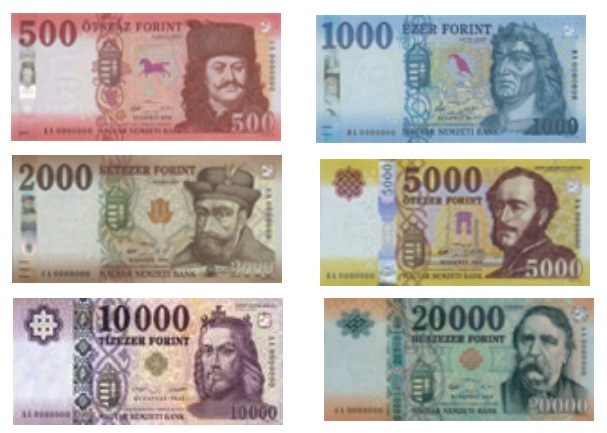
Current Hungarian forint banknotes
500 forint banknote (500 Ft)
This note of reddish tones came to light on July 4, 2018. It measures 154 mm x 70 mm and on the obverse shows the portrait of Ferenc Rákóczi.
Francis Rákóczi II of Felsővadász (1676-1735) led the Hungarian independence war of 1703-1711 against the rule of the Habsburgs in his capacity as prince of the confederate states for the freedom of the Kingdom of Hungary. He was also Prince of Transylvania, Imperial Prince and member of the Order of the Golden Fleece.
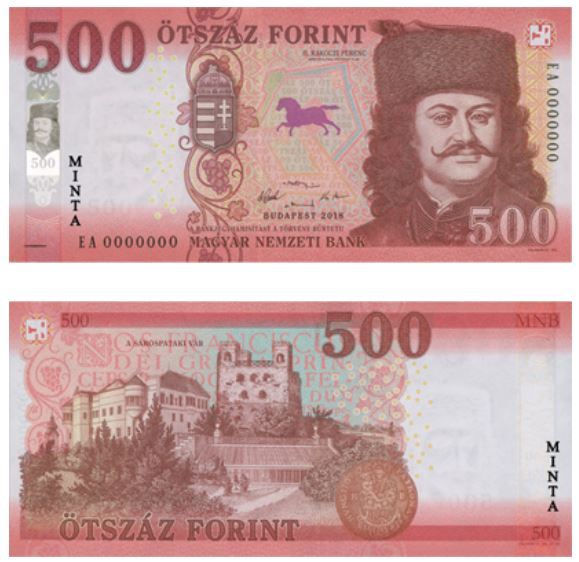
500 Hungarian Forints banknote (500 Ft 500 HUF)
The reverse shows a view of the castle of Sárospatak, city of Hungary (county of Borsod-Abaúj-Zemplén), at the foot of the Bodrog river. Sárospatak has the status of a city since 1201. King Andrew II of Hungary built the castle depcited on the note, where his wife Gertrudis gave birth to his daughter Elisabeth, the future Elisabeth of Hungary.
The countervaluation in euros at the exchange rate today in Spain of the 500 forints note is approximately 1,22 euros.
1000 forint banknote (1000 Ft)
This blue toned banknote came to light on August 24, 2017. It measures 154 mm x 70 mm and on the obverse it shows the portrait of King Matthias Corvinus also known as Matthias I. Born in 1443, he was king of Hungary and Croatia from 1458 until his death in 1490. In 1469 he became also king of Bohemia and adopted the title of Duke of Austria in 1487.
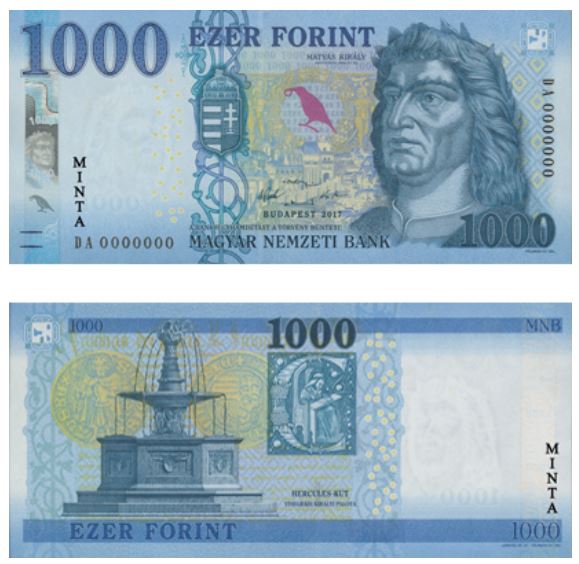
1000 Hungarian Forints banknote (1000 Ft 1000 HUF)
The reverse side of this 100 HUF banknote is dedicated to the Hercules fountain, of the Renaissance palace of Visegrad. The value in euros of this 1000 HUF banknote would be today in Spain of 2,44 euros.
2000 forint banknote (2000 Ft)
This brown toned note was released on November 15, 2016. It measures 154 mm x 70 mm as the 1000 florins note.
On the obverse it shows the portrait of Prince Gábor Bethlen or Gabriel Bethlen (1580-1629). Born in Iktár in 1580, he was a Hungarian noble, Prince of Transylvania. His contribution is due to his great scientific knowledge. Gabor is considered one of the most relevant figures in Hungarian history of the 17th century. Therefore, on the back of the note he appears speaking about science together with other scientists.
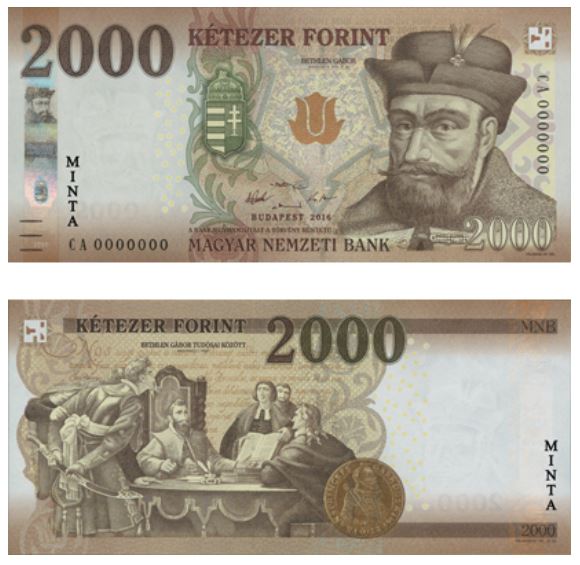
2000 Hungarian Forints banknote (2000 Ft 2000 HUF)
The value in euros of this 2000 HUF banknote would be today in Spain of 4,86 euros.
5000 forint banknote (5000 Ft)
This banknote of yellowish tones came to light on November 15, 2016 as well as the 2000 Ft note with which it also shares measures of 154 mm x 70 mm along with the 1000 florins note.
On the obverse appears the effigy of Count István Széchenyi (1791-1860). Stephan Széchenyi of Sárvár-Felsővidék, as he is also known, was a Hungarian politician and writer, nicknamed “the greatest of the Hungarians.”
On the reverse is the residence of Széchenyi´s mansion in the Hungarian population of Nagycenk, with about 2000 inhabitants.
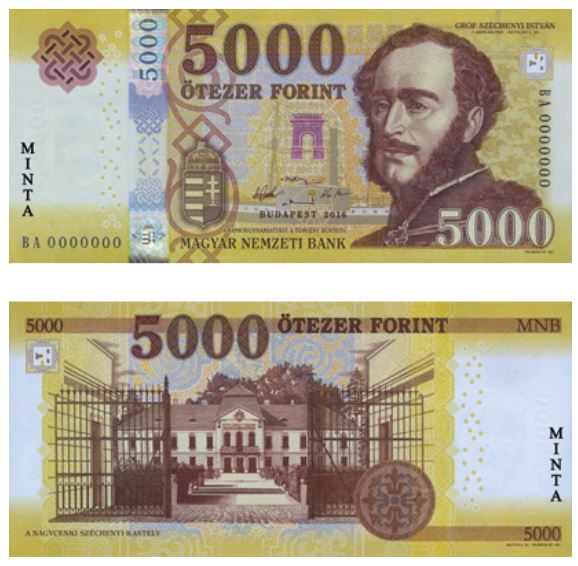
5000 Hungarian Forints banknote (5000 Ft 5000 HUF)
The value in euros of this 5000 HUF banknote would be today in Spain of 12,14 euros.
10.000 forint banknote (10.000 Ft)
This banknote of violet tones was released on September 2, 2014 and has the same measures as the other banknotes: 154 mm x 70 mm.
The obverse shows King Stephen I of Hungary (975-1038). Nicknamed “the Saint” or “the Great,” Stephen I was the last great prince of the Hungarians and the first king of Hungary.
The reverse shows views of his city of birth, Esztergom (Estrigonia) belonging to the county of Komárom-Esztergom in Hungary. Since the founding of the Kingdom of Hungary it became the residence of the archbishop of Esztergom, the highest hierarchy of the Catholic Church in the country.
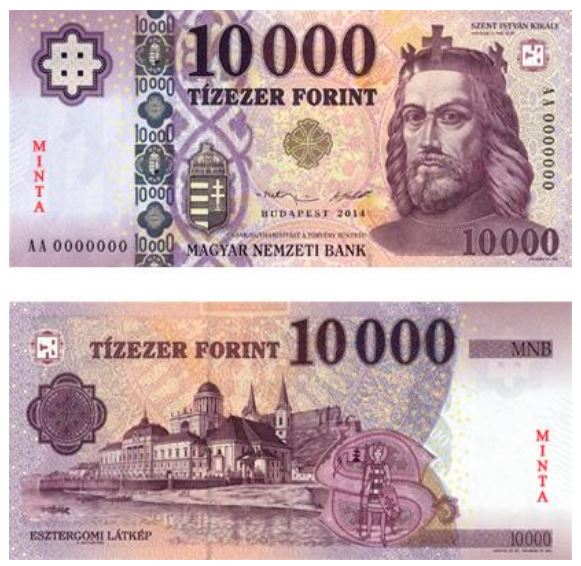
10000 Hungarian Forints banknote (10 000 Ft 10 000 HUF)
The value in euros of this 5000 HUF banknote would be today in Spain of 25 euros.
20.000 forint banknote (20.000 Ft)
This note of brown and green-blue tones came to light on September 25, 2015 and shares the same measures as the other notes: 154 mm x 70 mm.
The obverse shows Ferenc Deák of Kehida (1803-1876), a Hungarian politician known as “The Sage of the Fatherland.” On the reverse is the old parliament of Hungary.
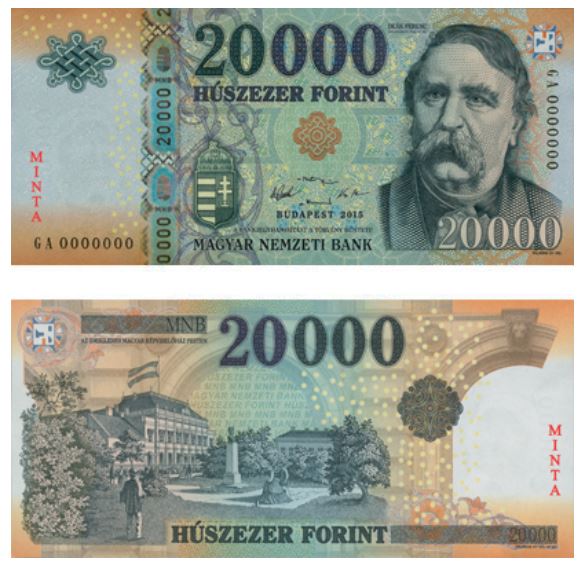
20000 Hungarian Forints banknote (20 000 Ft 20 000 HUF)
The value in euros of this 5000 HUF banknote would be today in Spain of 49 euros.
Banknotes out of circulation
Beware of out-of-circulation forint banknotes, since they have the same design as their predecessors but lack their innovative security measures. Look at this table with the different security measures for new banknotes.
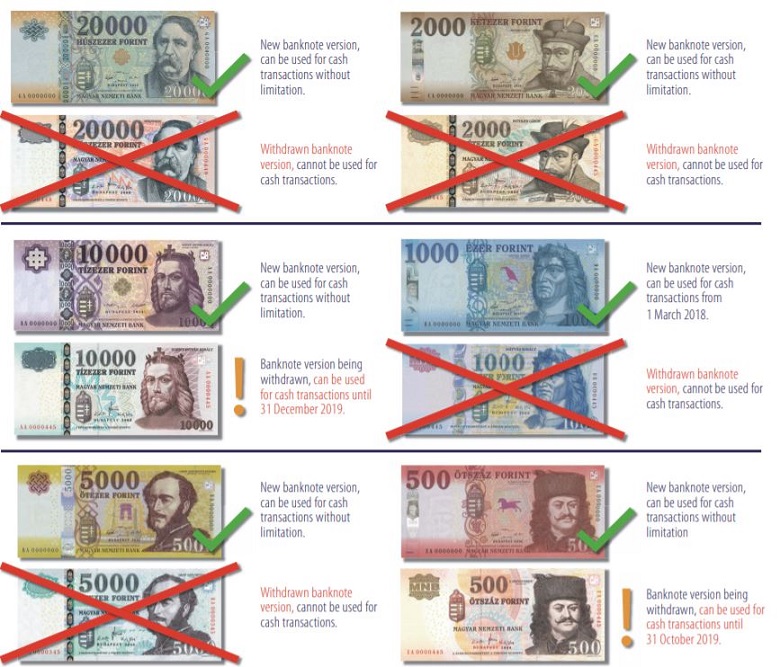
Good and fake guilder banknotes for Budapest Hungary in 2023
Hungarian forint coins in circulation
There are currently 5, 10, 20, 50, 100, 200 forints in circulation in Hungary. The countervaluation in euros of the highest value coin (that of 200 forints) would be equivalent to about 56 cents.
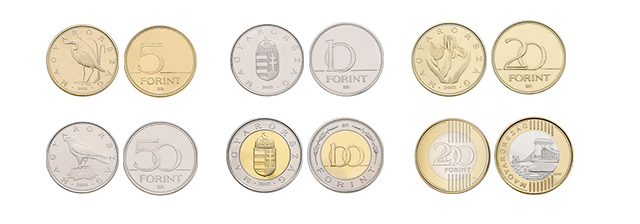
Hungarian forint coins in circulation
Euro to Hungarian forint exchange rate
The euro to forint exchange rates oscillates at all times. If you search on Google “euro to hungarian forint rate” you will find dozens of websites (“currency converters”) that offer a “rate” of the day. Something like this (June 22, 2023):
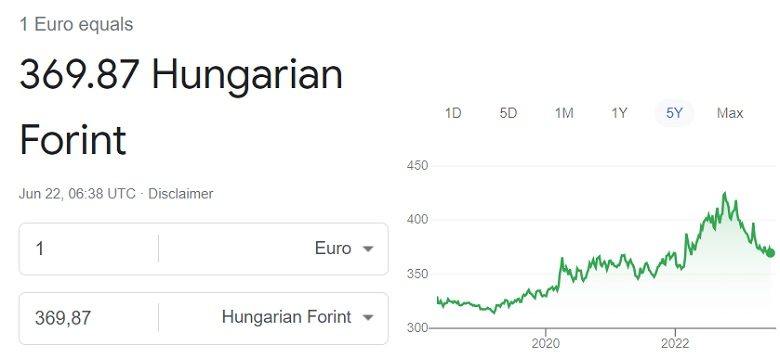
Euro to Hungarian forint exchange rate 22 06 2023
As you can see, the exchange rates last year have oscillated between 312 and 335 forints per euro, but keep in mind that this graph represents the value of the “currency” forint against the euro, and not that of the paper currency, which is lower.
In fact, in the currency providers in Spain you can buy today (June 22, 2023) Hungarian forints at an exchange rate of between 253.44 at any airport and 349.65 HUF for each euro from Cambiator. Nothing to do with the Euro to Hungarian florint currency exchange (369.69 today).
So, when you see these values in Google and other currency converters with your mobile, keep this in mind:
-This is an unreliable rate. That is, if you click on the “Disclaimer” link, you get this Google Finance warning: “Google cannot guarantee the accuracy of the exchange rates shown. Confirm the current rates before making a transaction that may be affected by changes in exchange rates. ”
-These rates you see are usually wholesale prices of the Hungarian forint currency against the Euro currency and not those of paper currency;
-Only banks can have these rates with each other. That is, it is impossible to get them as a individuals.
If you need paper forint banknotes you will have to go through the retail travel money market (bank or currency exchange supplier). This market means that the Hungarian forints have had to be “transported” by someone for you to enjoy them (or bought from travelers from Hungary passing through Spain previously).
In other words, moving banknotes from one place to another has logistic costs that will make their selling price more expensive (the exchange rate that will be applied to you by the seller).
The Hungarian forint is a currency not very common or abundant in Spain, so it is not so easy to find it available for sale. Therefore it is good to anticipate the purchase and order it online to get a better price.
Where to exchange hungarian forints in Spain
The 3 most popular places to change HUF in Spain are banks, currency suppliers and the airports.
Of these, the least recommended place to buy are airports and any business that charges you a commission in addition to a “margin of exchange” (difference between the price for which you paid the currency and the price for which they sell it to you).
That is, most banks and some currency providers charge you a commission when you change in person without first going through their website to book online and thus avoid this commission.
Changing 1000 euros to hungarian forints today
For example, if you want to change 1000 euros to florins, these are the prices you will find today in Spain:
- Main airports with Global Exchange (1 EUR = 253.44 HUF): 253,440 forints.
- Caixabank (1 EUR = 319.71 HUF): 310,110 guilders (minus 30 euros of commission).
- BBVA (1 EUR : 322.52 HUF): 312,840 guilders (minus 30 euros of commission).
- ING (agreement with Global Exchange) (1 EUR = 312.88 HUF): 312,880 forints.
- Cambiator (1 EUR = 349.65): 349,650 forints.
This means that for 1000 euros you would get 253,440 guilders at the airport (worst rate), and 349,650 guilders with Cambiator, the best rate of the day.
The difference between both options is today 96,000 forints, which at the exchange rate today in Spain would be about 233 euros more or less depending on where you make your currency exchange.
Euro to hungarian forint rate today in Spain
To know the Euro to Hungarian forint rate in currency providers, banks and your airport, in Spain, the best thing you can do is use our currency comparator. It is free and will save you money and time.
If your are in Spain or planning a visit, click on the link of your interest as you want to buy forints or sell them in exchange for euros and you will see where to get the best rates in your city (Madrid, Barcelona, Alicante, Valencia, Seville, etc.):
- Buy Hungarian forints with euros (EUR to HUF)
- Sell your Hungarian florins in exchange for euros (HUF to EUR)
Other popular currencies
Best rate of the day (exchange euros to another currency)

Sin comentarios